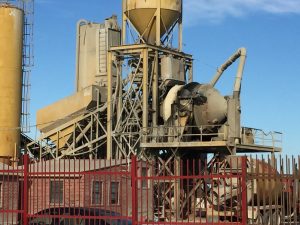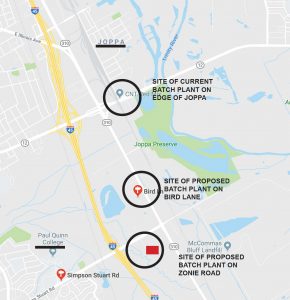Particulate Matter
Xmas Brings a “Miracle on Choate Street”

Blue Star “Recycling” exposed by citizens and
reporter as one big illegal asphalt dumping
ground in South Dallas
City forces closure…once it finds out about it
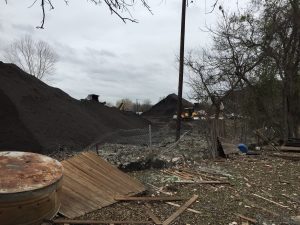
The view from Marsha Jackson’s backyard
Last week there was what you might describe as a kind of South Dallas Christmas Miracle Story – as in, “It was a miracle the city finally did anything to stop that crap.”
For a blow-by-blow account of how it all went down, you can read Dallas Morning News city columnist Robert Wilonsky’s account in two separate installments that ran in last Thursday’s and Friday’s paper here and here.
They tell the saga of Marsha Jackson’s one-woman fight to save her home of almost 30 years from being swallowed up by huge mountains of asphalt and used shingles by a company claiming to recycle them. A company that only popped up in the last 12 months or so and has completely destroyed her quality of life.
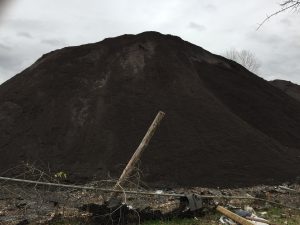 No photos or video can do her situation justice. Towering 3-5 story piles of what looks like coal dust are looming over her house, right up to the fence line that’s broken because of them. Heavy-duty diesel equipment is everywhere and in constant motion, moving piles of asphalt chips and shingles around. Large shingle-shredding machines spit out chips from both ends. A foul-smelling asphalt cooking operation adds a sulfuric haze. It goes on well into the night.
No photos or video can do her situation justice. Towering 3-5 story piles of what looks like coal dust are looming over her house, right up to the fence line that’s broken because of them. Heavy-duty diesel equipment is everywhere and in constant motion, moving piles of asphalt chips and shingles around. Large shingle-shredding machines spit out chips from both ends. A foul-smelling asphalt cooking operation adds a sulfuric haze. It goes on well into the night.
Ms. Jackson has been complaining about this situation to everyone, from the Texas Commission on Environmental Quality to the City of Dallas, for over a year. Despite her best efforts those complaints never got heard or acted upon. It might have remained that way for a good while longer.
Instead, what happened to Ms. Jackson is the kind of thing that usually only happens in movies.
On November 13th, Ms. Jackson met tenacious Temeckia Durrough of the Joppa Freedman’s Township Association at a community meeting about the new Lane Plating Superfund site in South Dallas. They exchanged their own outrages. Temeckia invited Ms. Jackson to come to the next Let Joppa Breathe Alliance meeting on December 4th to tell her story and add some people power.
She did and then she begin sending photos and video of what was right outside her window. Those prompted visits to collect our own evidence. Sprawling over multiple acres, artificial ridges of asphalt bits and and shingles ring the site and come right up to the edge of a creek that flows into the Trinity River a short distance away. There’s nothing to keep those piles from sliding into the creek and sure enough, that’s what’s been happening over the last year.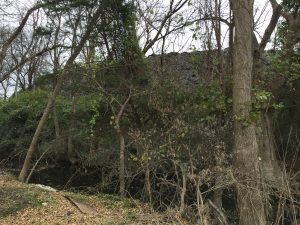
Exasperated by the actual site, Downwinders then reached out to a handful of local reporters capable of throwing a hot and heavy spotlight on an injustice. “Please help this woman living under/on top of a growing giant asphalt blob“ was the subject line of our December 10th plea. We suspected the only way to cut through all the reasons why nobody could help Ms. Jackson was to expose the fact that nobody was helping her.
To his credit Dallas native Robert Wilonsky, city columnist for the Dallas Morning News, answered the call. He went out to Marsha Jackson’s house and like everyone else except the agencies who are supposed to be outraged by this kind of thing, was indeed outraged. And that’s when things started to happen.
After trying to get basic information on Blue Star from Dallas City Hall he was even madder. Like the rest of us mere citizens, he was told he’d have to file an Open Acts Request – just to see the city inspection files, certificate of occupancy, etc. But maybe the reason the City didn’t want anyone looking is because Blue Star didn’t have ANY of the necessary paperwork to do what it’s doing, as Wilonsly later found out.
Because he was snooping around City Hall, Wilonsky was contacted by District 8 City Council Member Tennell Atkins on Wednesday, December 12th. Wilonsky urged Atkins to look into the awful situation…in his own council district. That he’d been getting complaints about for months.
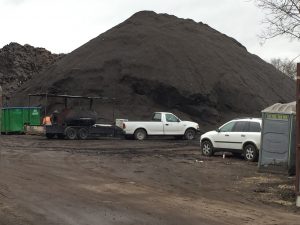 But after a visit, code compliance officer in tow, Atkins was full of righteous indignation. As was the Dallas Office of Environmental Quality and (Rockefeller) Sustainability, whose Director only learned about Blue Star from Wilonsky in passing…on Thursday the 13th, when Wilonsly’s first column on Blue Star went up in the early afternoon.
But after a visit, code compliance officer in tow, Atkins was full of righteous indignation. As was the Dallas Office of Environmental Quality and (Rockefeller) Sustainability, whose Director only learned about Blue Star from Wilonsky in passing…on Thursday the 13th, when Wilonsly’s first column on Blue Star went up in the early afternoon.
By Friday, December 14th, a month and a day after Marsha Jackson and Temeckia Durrough first met, the City was filing motions in court to close Blue Star down for at least a week. Considering how much official paperwork is lacking on the site, the fact that it’s the subject of an on-going TCEQ investigation, and is sorely liable to lawsuits by its neighbors, let’s hope it never opens again.
We don’t know how those huge piles are going to get cleaned-up yet but at least they’re not being added to. For now, the activity on the site that was a constant nuisance and health threat to Marsha Jackson has ceased.
In less than seven days the phone calls and emails of the most widely read local columnist for the only daily in town won a victory that months of campaigning through official channels by an ordinary citizen had been unable to pull off. Time and again the system let Marsha Jackson down until that institutional failure was the story that made the outrage stop.
Call it Ms. Jackson’s own hard-won Christmas Miracle.
Was it not for her persistence, this series of unlikely events could not have happened. Were it not each supporting link in the chain along the way – Ms. Douglas’ fateful invitation to Jackson to attend a community meeting, our gigging local journalists, one of those journalists actually being interested – there would be no happy ending to report yet. That’s how tenuous environmental justice is in Dallas.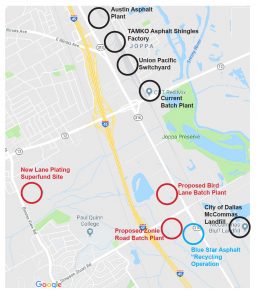
Besides showing the rewards of desperate determination, it was a lesson in grassroots perspectives for Reporter Wilonsky as well. Like most of us, he was dumbstruck by the fact that you can’t simply make an appointment to show up at City Hall, sit down, and read the official records on a company doing business next to you. Like many of you, he found out firsthand how passive the City is toward on-going disasters like the one next door to Ms. Jackson…until they become fodder for a front page column.
But we can’t depend on a single reporter to do the work of whole agencies, no matter how influential. This was the exception that proves the rule.
Even while the spotlight shone brightly on Blue Star, a hearing on a zoning change allowing a new concrete batch plant right around the corner was taking place at City Hall with a recommendation by city staff that it be approved. It’s one of two being sought in the same stretch of SM Wright freeway, which isn’t too far from the new Lane Plating Superfund Site, which isn’t too far from the TAMKO asphalt roofing shingles factory, the large Union Pacific switch yard, the Austin Asphalt plant and the Redi-Mix batch plant in Joppa. Fortunately, citizens were there to stop that mistake from happening as well.
Instead of seeing these as individual facilities like City Hall does, they should be seen as symptoms of the same problem of obsolete racist zoning plaguing South Dallas. As long as heavy industry is allowed to plop down next to homes in a way not allowed in east or north Dallas, you’ll see wave after wave of Blue Stars and batch plants targeting this area.
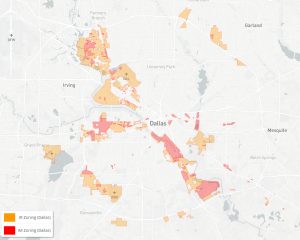
A wholesale examination of industrial zoning, of zoning that pollutes, should be taking place at Dallas City Hall as part of its revamped Economic Development policy. In the same way that the City recently said it won’t be a party to adding to concentrations of poverty through the siting of low income housing, it should also be policy not to add to concentrations of pollution in neighborhoods already absorbing more than their fair share. This requires a proactive perspective that has no sign of showing up within the ranks of the Office of Environmental Quality and (Rockefeller) Sustainability staff any time soon. That means residents are going to have to do this themselves – despite staff.
Just like Ms. Jackson, they’re going to have to be persistent in their demands. They’re going to have to stay focused. And maybe, just maybe if the right combination of chords can be struck, in the right sequence, at the right time, another more far-reaching chorus of “Hallelujah” can be sung in praise of a civic miracle. This time for all of South Dallas.
Environmental Justice Alert! Help Us Stop the First of Two New Batch Plants Proposed for South Dallas
Plan Commission Action THIS Thursday
You can send a email opposing both proposed batch plants to the Plan Commission today
JUST CLICK HERE
On Thursday the Plan Commission will vote on an SUP for the Bird Lane batch plant site – one of two being proposed by Estrada Concrete along the Stuart-Simpson/Central corridor in South Dallas.
There is more than a little suspicion that this is a backdoor way to get the pair of batch plants that were defeated by Joppa residents in March back in play – only in a more business-friendly council district. The two new requests are coming from a very small company run out of a house with only one batch plant in operation now, located in an industrial park in Hutchins just six minutes down the highway.
To defeat this bad idea we need you to:
1) let the Plan Commission know you oppose the batch plants and the zoning changes they require ASAP. Please use our simple ClickNSend email letter template to send a letter of opposition. Add your own comments if you want. It’s already addressed to all the Plan Commission members. All you have to do is fill it out and “click send.”
2) show up on Thursday at the Plan Commission to voice your opposition in person if you can:
DALLAS CITY HALL
CITY PLAN COMMISSION MEETING
THURSDAY, DEC 13th
ROOM 5ES
1:30 pm
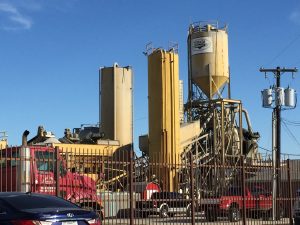
Staff has recommended approval of a Special Use Permit to operate a batch plant for three years at this Bird Lane site, which is next to homes and right around the corner from a second batch plant site the same company – Estrada Concrete – is pursuing via a zoning change request.
Since there are two sites there are two votes. The other site won’t come up for a vote until January 3rd at the earliest, but this Bird Lane site is gong through the pipeline now.
What’s needed now is sending these Plan Commission members lots and lots of emails saying we oppose these zoning changes and Special Use Permits AND are seeking a individual hearing for the Bird Lane site on the 13th.
There are two different types of agenda items when it comes to city decisions. One is the “individual” agenda item for which topics will be discussed and the public can make comments.
The other type of agenda item is a “consent” agenda item in which case the topic is not discussed and the group simply votes on it with the understanding that most agree with what is being proposed.
In this case, the batch plant’s Specific Use Permit (SUP) request has been recommended by staff for approval for a three year period and it is assumed that none of the city plan commissioners oppose the staff recommendation.
Dallas residents opposing this Bird Lane batch plant should contact their own District’s Plan Commissioner and City 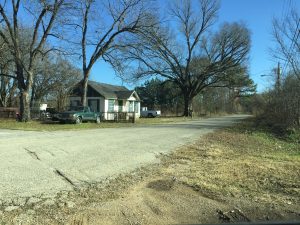 Council Member and let them know know you want the Plan Commission to pull the item from the “consent” agenda so it will individually discussed on the 13th as part of the public hearing portion of the agenda instead of the done deal “consent” part.
Council Member and let them know know you want the Plan Commission to pull the item from the “consent” agenda so it will individually discussed on the 13th as part of the public hearing portion of the agenda instead of the done deal “consent” part.
A hearing requires the public to be heard and a recorded vote take place by Plan Commission members for some kind of action – Delay, Disapproval, or Approval. We get to make our case against the batch plant only if it’s pulled off the consent agenda.
Folks opposing the zoning change may speak against the staff’s recommendation if they choose. The hearings start at 1:30 PM and can last through the early evening. It’s hard to tell what time the item will be heard, so be prepared to come and stay awhile.
The CPC docket is available https://dallascityhall.com/government/meetings/DCH%20Documents/plan-commission/12-13-2018_CPC_Docket.pdf
CLICK HERE TO SEND YOUR LETTER OF OPPOSITION
San Antonio and Houston Move Forward with New Regional Air Monitoring Networks. Dallas Doesn’t.
Last time we reported on the prospects of a new regional air monitoring network the idea received a 7-0 vote from a Dallas City Council Committee on September 24th but was delayed by staff request from going to the council until December 12th.
There was conjecture at the time that the delay was an excuse to actually find ways to kill the idea and if that was the goal, it’s 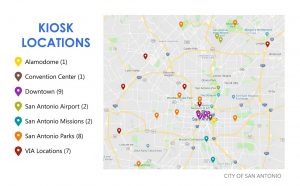 succeeding so far. After a year of hearing no objections from Dallas staff to the idea of establishing an independent entity among local governments to run the network, all of a sudden City Hall took great offense at the very idea.
succeeding so far. After a year of hearing no objections from Dallas staff to the idea of establishing an independent entity among local governments to run the network, all of a sudden City Hall took great offense at the very idea.
Over the past month Dallas County has been in talks with Dallas city staff to find another way to implement the network. Government-sponsored non-profits are being studied. Downwinders continues to advocate a entity that assures public participation in decision-making and robust enough to maintain a growing network of different monitors in different cities. Without more progress being made quickly it’s hard to figure out how the proposal makes it before the Council by December 12th.
While Dallas delays, both San Antonio and Houston are proceeding with their own new air monitoring networks.
In San Antonio, it’s through a deal with IKE Smart City that will trade ads on kiosks for 30 free kiosks that will give directions, recommend local eateries, provide free WiFi in a 150-foot radius, and take Particulate Matter pollution readings. The project is funded entirely by IKE Smart City. Unlike DFW, San Antonio hasn’t even violated the Clean Air Act and it already has more monitors than the Metromess.
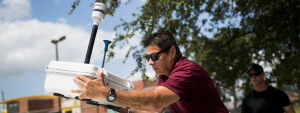 Beginning in December 2017 the Environmental Defense Fund working with the Houston Health Department and the university of California Berkley placed 20 air quality sensors across the city. Some were placed in known pollution hots spots like the predominantly black neighborhood of Pleasantville on Houston’s east side, where pollution from warehouses, metal recyclers, salvage yards, an Anheuser-Busch’s Houston brewery and an interstate often make it hard to breathe.
Beginning in December 2017 the Environmental Defense Fund working with the Houston Health Department and the university of California Berkley placed 20 air quality sensors across the city. Some were placed in known pollution hots spots like the predominantly black neighborhood of Pleasantville on Houston’s east side, where pollution from warehouses, metal recyclers, salvage yards, an Anheuser-Busch’s Houston brewery and an interstate often make it hard to breathe.
“If somebody asked me how many fixed site monitors we need, I would say there are never enough,” said Loren Raun, chief environmental officer with the Houston Health Department, which has since received funding to purchase similar instruments from Entanglement Technologies.
One can’t imagine anyone on Dallas city staff saying the same thing. In fact on more than one occasion staff has said they’re just fine with the nine monitors the Texas Nature Conservancy is due to be installing at Dallas schools this year and they’re in no rush to add any more.

Just another day in Joppa
And one especially can’t imagine Dallas city staff going along with putting monitors in known Dallas pollution hot spots like Joppa or West Dallas. Despite the recent controversy over the proposed two new batch plants rejected by the City Council in March – in part because of portable monitor readings from Downwinders showing already high levels – staff said recently they still have no plans to purchase their own air sensors.
This kind of official rebuff to high tech low cost sensors gives lie to the city staff’s rhetoric about “Smart Cities”as well as its sudden concern over asthmatic black kids. If staff really cared about them, why wouldn’t it buy air monitors it could use in field to investigate complaints in their neighborhoods instead of just guessing the air quality there, or using an EPA monitor nine miles away to claim everything was just fine? Why wouldn’t the City be rushing to install monitors in hots spots like Joppa? Because statements made in pursuit of Rockefeller Foundation grants do not carry the force of law, or even as it turns out, curiosity.
Electric Buses: A Big Climate Change and EJ “Something You Can Do Now”
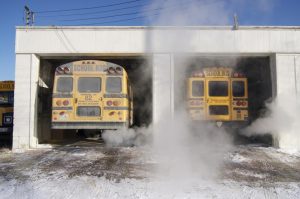
Register for the Electric Glide Bus Pub Crawl here.
Thursday, December 6th
Catch the bus at 6:30 or 7:00 pm
at the Green Door in the Farmers Market District
600 South Harwood Dallas 75201
Plug In. Get Lit. Stay Current.
How did we get from cement plants burning hazardous waste in Midlothian to transit or and school buses making runs in inner city Dallas?
The answer is PM, Particulate Matter. The two-decade fight against the cement plants was one long primer on PM pollution. They were, and remain the largest industrial sources of the pollution in North Texas. We learned firsthand about the toxicity, reach, and insidious health effects of PM pollution. Not just strokes and asthma, but IQ loss, Autism, Dementia, Diabetes, low-weight births. PM is the new lead.
Every boiler, furnace, fire, flame and combustion engine produce PM. Diesel engines emit an exceptionally toxic form of PM called Black Carbon.

Because they’re on the road so much, are diesel or natural gas-powered, and make people wait by the side of traffic-heavy roads to ride, bus systems turn out to be a major source of PM pollution. And climate change gases. And smog. A rough estimate shows DART’s bus fleet would be the 10th largest PM source in Dallas County if it were all parked in one spot. But of course its the dispersed nature of a bus fleet’s pollution that often makes it more of a widespread threat to public health than a stationary “point source” a.k.a. an industrial facility.
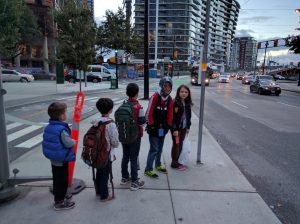
What’s missing is a constituency for electrification of school district bus fleets and transit agencies like DART and Trinity Metro. Because of the potential impacts and benefits, this could be a wide-ranging and powerful alliance – PTAs, transit riders, physicians, environmentalists, environmental justice advocates, and even the utilities that could buy the power from bus batteries. But until we get the ball, er wheel rolling, its all just that – potential.
One of the reasons we’re sponsoring the December 6th “Electric Glide bus pub crawl” as part of this year’s Root and Branch is that we wanted to start that rolling. And real, wheels-on-the-bus-go-round-and-round rolling discussions and presentations on the advantages of electric buses are part of the evening, but so is just showing your support for the goal of electrification as something local officials could accomplish right now, especially if they combine their collective purchasing power.
The more people that show-up on the 6th, the more DART and local school boards – whose memberships we’re inviting as well – will get the impression someone gives a damn and the more we’re a force to be reckoned with. We need a people’s lobby for 21st Century electric buses in DFW.
 In exchange for coming out and forking over $25, we give you three custom drinks, Graham Dodds’ food, a presentation by Dale Hill, the co-founder of the Proterra electric bus manufacturer, and maybe, just maybe some food for thought about what we all can do right now to advance a bunch of causes in one campaign that’s winnable at the local level in the Trump era.
In exchange for coming out and forking over $25, we give you three custom drinks, Graham Dodds’ food, a presentation by Dale Hill, the co-founder of the Proterra electric bus manufacturer, and maybe, just maybe some food for thought about what we all can do right now to advance a bunch of causes in one campaign that’s winnable at the local level in the Trump era.
Register for the Electric Glide Bus Pub Crawl here.
Thursday, December 6th
Catch the bus at 6:30 or 7:00 pm
at the Green Door in the Farmers Market District
600 South Harwood Dallas 75201
Plug In. Get Lit. Stay Current.
End of Year Report: DFW Smog Goes Up While Going Down; PM is Worst Since ’03
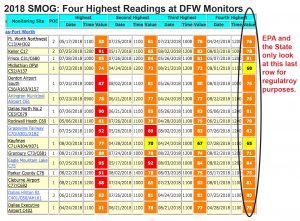
Only in the nonsensical world of EPA air quality regulation could the official regional average for DFW smog actually decrease despite the worst levels of DFW Ozone pollution in five years.
In 2018 a quarter of all North Texas official monitor sites recorded smog levels in the 90-95 ppb range for more than an hour. 2018 was the first time in two years that any DFW monitors have had 8-hour averages of 80 ppb or above, and the first time since 2013 since there been at least six. In fact, this year’s total number of 80-or-above monitors is almost equal to the total number from the last five years combined.
Nevertheless, the regional average for smog pollution that determines government action actually went down from 81 to 76 parts per billion.
How does that happen? Not without a lot of numerical manipulation. EPA’s formula for smog pollution classification is a two part affair. First EPA only counts the highest 4th highest annual reading from each monitor in DFW. That means every monitor gets three “Mulligans” or “do-overs” before the results are eligible for regulatory use. Then EPA combines the last three year’s worth of those highest 4th highest readings to produce a rolling average. So that 2018 average is actually the results of the highest 4th highest reading from 2016, 2017, and 2018.
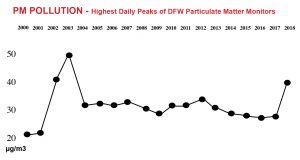
High readings from the summer of 2015 are rolling out of that three-year rolling average, while lower readings in ’16 and ’17 remain. While this year’s smog levels were higher, but not so extraordinarily high as to be able to counter the lower numbers making up the rest of the average.
But our smog was bad enough last year and this to once again make sure DFW is in “non-attainment” of the clean Air Act for the pollutant. For the umpteenth time in a row, we missed a deadline for meeting a Clean Air Act smog standard – this time it’s the 2008 75 ppb standard. If EPA follows its own protocol, that means DFW will be go from being “moderately” out of compliance to being in “Serious” non-compliance.
And please remember all of these numbers are based on only 20 smog monitors, half of which are located well-outside the DFW urban core, and none of which are located in Wise County, where Downwinders is doing the job of monitoring ozone pollution that the State and EPA refuse to do.
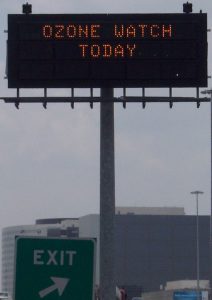 What are the consequences of this continuing violation of the Clean Air Act that imperils public health? Nada probably. At least while the Trump Administration holds office. In the past such classifications would have triggered a process leading up to some kind of official plan of action that, at least rhetorically, is aimed at correcting the 30-year old problem. But no one expects the State of Texas, or now the EPA, to take that responsibility seriously.
What are the consequences of this continuing violation of the Clean Air Act that imperils public health? Nada probably. At least while the Trump Administration holds office. In the past such classifications would have triggered a process leading up to some kind of official plan of action that, at least rhetorically, is aimed at correcting the 30-year old problem. But no one expects the State of Texas, or now the EPA, to take that responsibility seriously.
What you can expect is some official TCEQ spin about how it’s been successful in bringing down smog pollution levels. In fact, it was the wettest September on record that brought an abrupt end to what was shaping up to be an even worse smog year than it already was at the end of August. Historically, September is when DFW sees some of its worst bad air days. But not this year.
Accompanying the rise in smog pollution in 2018 was also a dramatic rise in the regional numbers for Particulate Matter (PM) pollution – the highest North Texas has seen since 2003.
After a long spell of annual peaks of between 24 and 28 migrograms per cubic meter of air, the 2018 average for highest daily readings among all sites has risen dramatically as of this month – to almost 40 µg/m3
Before this year, they’d only been four daily peaks above 40 µg/m3 over the last 15 years. In 2018 four out of 6 PM monitoring sties had registered daily readings averaging between 41 an 43 ppb as of October.
The EPA annual standard for PM pollution is 12 µg/m3. The 24 hour standard is 35 µg/m3.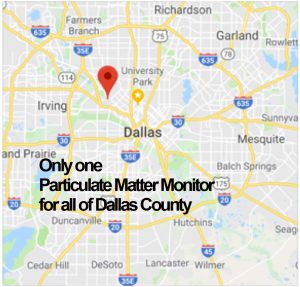
As with smog, these readings are coming from a very small pool of monitors – in this case just six PM monitors scattered over an area only slightly smaller than Rhode Island.
Some of this might be blamed on the drought we we experiencing during the summer and increased dust circulation, but comparing it to 2011 when similar if not worse conditions were in play shows no similar bump then. Fewer coal plants blowing their plumes into DFW this year might lead you to think we were even due for a drop. Instead it’s as if someone turned the key on a couple more. There’s no obvious reason why PM levels would have jumped so much in a single year.
What’s clear is that local governments are the last refuge for effective and new air pollution control measures. Until political leadership changes in Austin and/or Washington, there’s no expectation of any relief. In fact, every day sees new proposals from the State or EPA that will actually increase smog and PM pollution in DFW. This is why local city and county elections are just as important as state and national ones.
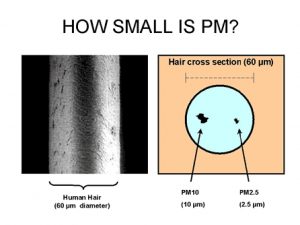 We’ll have to wait until the end of 2019 to see if this rise in pollution averages is a trend or blip, but there’s no question that smog and PM are taking their toll on public health in DFW. Study after study shows harms at levels of exposure well below these annual and daily averages that determine EPA regulations. In the real world, your lungs, heart, brain and immune system don’t seem to be able to distinguish between “safe” and “unsafe” levels of poison as defined by the government.
We’ll have to wait until the end of 2019 to see if this rise in pollution averages is a trend or blip, but there’s no question that smog and PM are taking their toll on public health in DFW. Study after study shows harms at levels of exposure well below these annual and daily averages that determine EPA regulations. In the real world, your lungs, heart, brain and immune system don’t seem to be able to distinguish between “safe” and “unsafe” levels of poison as defined by the government.
Joppa Becomes Citizen Science Case Study; Next Portable Monitor Training Session Oct 28th

Shannon Gribble and Cresanda Allen on a monitoring run in Joppa
You’re Invited to Train on the Same Portable Monitors & Get Access to Our Monitor Lending Library…For FREE
CITIZEN SCIENCE TRAINING SESSION
SUNDAY OCTOBER 28th
1-3 pm
GOODWORK CO-WORKING SPACE
1808 S. GOOD-LATIMER
Let us know you’re coming: RSVP downwindersatrisk@gmail.com
Downwinders is proud to announce that our precedent-setting use of portable PM monitors to help Joppa residents defeat two proposed batch plants earlier this year was selected by manufacturer Aeroqual as a case study showing how its new air pollution technology has made a positive difference in the world.
Joppa will join other examples from places like Tanzania, Iraq, India, and Peru on the Aeroqual website. It will be the only success story attributable to a citizens group as opposed to a government agency, university, or business.
“Timing is everything” is a cliche but in this case the banality is on point.

Aeroqual’s new 500 series hand held portable PM monitors had only become available in January of this year, at exactly the time Downwinders was looking for a device that was highly reliable but not prohibitively expensive. In offering the 500, New Zealand-based Aeroqual carved its own market niche and met our criteria like a glove – more reliable than the extremely cheap consumer sensors you can buy on Amazon and less expensive than similarly calibrated machines affordable only to universities, industry and government.
Because they were so new, we had to call Aeroqual in New Zealand to order them directly. We were their first US customers. Downwinders ordered two for deployment in our PM Pollution Prevention campaign. When they arrived in late February, they were the only ones being used between New Zealand and the US.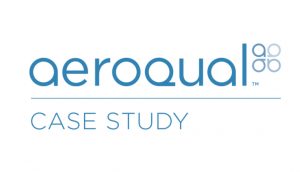
Since then, the company has made huge inroads into the US market, to the point of partnering with the EPA in Los Angles to establish a 100-monitor air network for Particulate Matter and smog pollution, and being considered for the monitor in the City of Dallas/Texas Nature Conservancy Breathe Easy study.
Downwinders’ original plan was to use the monitors to document PM levels along DART routes as research for our Green Streets bus electrification effort and set out for a couple of weeks doing nothing but measuring levels of PM inside and outside of buses.
We were still doing that when we got a call from the Joppa Freedman’s Township Association to request we turn our attention to their fight over two new batch plants.
Aeroqual’s portable machines provided the first, and so far only, air sampling in Joppa. They recorded significantly higher PM levels than the official EPA site some nine miles away. This was the same EPA site Dallas city staff was using to give Joppa the all-clear. The fact that the Aeroqual monitors came factory-calibrated out of the box and were supervised in their use by a local atmospheric scientist enhanced their credibility.
Their results were widely publicized only days before the City Council vote and combined with opposition on the ground, contributed to the council vote against the batch plant permits. It was the first time in local history, and we’re pretty sure in Texas or even the country, that this new technology became a tool for citizens in a successful permitting battle. And that’s why we’re ending up as the first citizens group case study for Aeroqual.
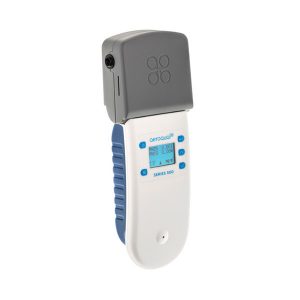
NOW IT’S YOUR TURN: MAKE HISTORY
CITIZEN SCIENCE TRAINING SESSION
SUNDAY OCTOBER 28th 1-3 pm
GOODWORK CO-WORKING SPACE
1808 S. GOOD-LATIMER
Let us know you’re coming: RSVP downwindersatrisk@gmail.com
This training session is a chance to become familiar with this new technology and work your way toward being able to check out these portable monitors on your own. No previous experience required. No math or engineering degrees necessary. If you can push buttons and read numbers, you can do this. It only takes two hours.

Along with first-timers, graduates from our first classes of Apprentice Citizen Scientists are invited back to take a field trip with our PM Committee and step-up to “Researcher” status. After one more outing, they’ll be given permission to check out the monitors for their own purposes or to help with our projects.
We’re entering a new era of Do-It-Yourself Environmental Protection. Learn how you can join it.
First Citizen Scientists Graduate From Portable Air Monitoring Training Class

L to R: Amanda Poland, Misti O’Quinn, Dr. Tate Barrett, James Orenstein, Temeckia Derrough, Candice Johnson, Evy Mayo, Jim Duncan, Kim Limberg, Liz Alexander, Miriam Mathews Fields and Cresanda Allen
In the middle of the wettest day in the wettest September DFW had ever recorded, the clouds parted and a dozen brave and curious souls turned out to go through the region’s first citizen science training for portable air monitoring.
Some were already clean air activists. Some were technology geeks. Some were people simply interested in having the ability to tell what’s in the air they’re breathing.
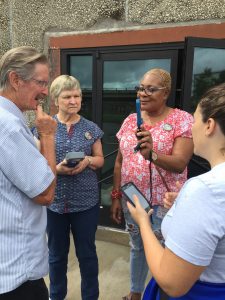 When they showed up to our GoodWork headquarters they got a tag team education on Particulate Matter pollution courtesy of a curriculum designed and presented by Downwinders board members and scientists. The information set-off lively discussions among residents of Joppa and West Dallas where PM problems are common. For others, the facts brought new awareness about this under-publicized but insidious pollutant.
When they showed up to our GoodWork headquarters they got a tag team education on Particulate Matter pollution courtesy of a curriculum designed and presented by Downwinders board members and scientists. The information set-off lively discussions among residents of Joppa and West Dallas where PM problems are common. For others, the facts brought new awareness about this under-publicized but insidious pollutant.
But no doubt many thought the real fun started with the hands-on field training using Downwinders’ three Aeroqual 500 Portable PM monitors. Despite the forecast, there was actually no rain during either the morning or afternoon session and the future scientists got to go explore inside and out.
They recorded the dust explosion set off by simply sweeping the floor with a broom. They saw how a lit match changed the composition of the air in a room. They stood downwind from fog machines that were faux-smokestacks for the day and they measured the ambient air in Sunny South Dallas on Good-Latimer. They learned how to sync meteorological tools with the monitors and record the necessary information to make a sampling more useful. They asked questions, they got in arguments and at the end of it all, they got certified as an official Citizen Science Apprentices. They’ll now be able to go out with our PM team for supervised research runs and after two of those they’ll be able to check out monitors on their own through our monitor lending library.
Our PM Committee is already looking to host another training session on a weekend in late October and these will be reoccurring on a regular basis from here on out. Be the first one on your block.
The Long March To Environmental Justice Begins with First “Let Joppa Breathe Alliance” Meeting
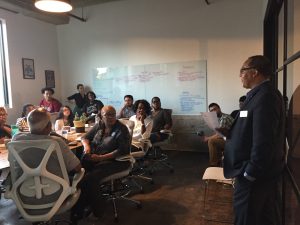
Council Member Kevin Felder welcomes participants to the Let Joppa Breathe meeting at GoodWork last Monday night.
Approximately 20 representatives from advocacy groups, non-profits, and neighborhoods gathered last Monday evening at GoodWork for the very first meeting of the “Let Joppa Breathe Alliance.” It was the first step in organizing a city wide effort to reverse over a century of racist zoning and land use planning in Dallas’ oldest Freedman’s community.
Besides Downwinders, there were members of Joppa Freeman’s Township Assocition, the South Central Civic League, the Inclusive Communities Project, Paul Quinn College, the NAACP, North West Texas Legal Aid, and Mia Carmen Theater company. As impressive as the breadth of support was, it was also the first time in memory that whites constituted a tiny fraction of attendance at a citywide Dallas environmental strategy meeting.
Rage Almighty, the spoken word artist who MC’d the May 22nd Joppa benefit was back to facilitate. District 7 Council  Member Kevin Felder was also back to welcome participants and encourage the building of the broadest possible coalition to win victories.
Member Kevin Felder was also back to welcome participants and encourage the building of the broadest possible coalition to win victories.
On the agenda were updates from the community, including photographic evidence presented by JFTA’s Temeckia Derrough of continued dust and diesel pollution problems from the existing Martin Marietta batch plant operation. There are continuing rumors about the company coming back to request a second chance at permitting the two proposed batch plants that were denied by the city council in March.
There was also discussion about how the group can estimate the emissions from all the short-haul diesel locomotives going back and forth in the Union Pacific switch yard that runs the length of the entire community. Usually the engines that end up in a switch yard are already old and in need of maintenance – yard duty is seen a step away from retiring the locomotive. Their exhaust contains a very toxic form of PM called Carbon Black that’s more carcinogenic than your average PM pollution. Electrification of these locomotives would eliminate a significant source of PM pollution in Joppa.
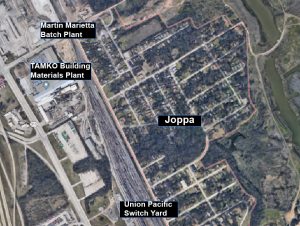 Misti O’Quinn with Downwinders reported that the group and UTD were very close to reaching a deal to place the first air monitor in Joppa, with a location to be announced soon. Another ten have been ordered and will probably be ready to be installed by November. The search is on for locations, with emphasis on getting front line readings close to batch plant, switch yard and the TAMKO shingles plant.
Misti O’Quinn with Downwinders reported that the group and UTD were very close to reaching a deal to place the first air monitor in Joppa, with a location to be announced soon. Another ten have been ordered and will probably be ready to be installed by November. The search is on for locations, with emphasis on getting front line readings close to batch plant, switch yard and the TAMKO shingles plant.
Plans are in the works to have a neighborhood enforcement workshop that includes the staff from City of Dallas Office of Environmental Quality, North West Texas Legal Aid attorneys and others advising residents how to be more effective in making complaints that can stick and lead to changes. Tentative scheduling has it penciled in for a date in later October or early November.
Participants scheduled the next Let Joppa Breathe Alliance meeting for 6 to 8 pm on Tuesday, October 23rd at GoodWork Co-Working space, 1808 S. Good Latimer. All groups are invited to send a representative. This isn’t just an environmental issue. It’s a civil rights issue. The more groups we represent, the faster we can get needed change.
The North Texas Clean Air Network Gets an Unanimous Vote in its First Dallas City Hall Test…But Staff is Still Resisting
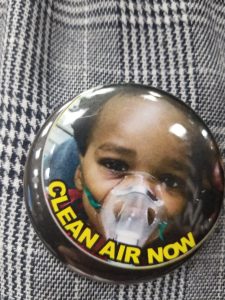 Rebuking its own staff’s misinformation campaign, the Dallas City Council’s seven-member Quality of Life Committee voted unanimously at its Monday morning meeting to recommend joining the North Texas Clean Air Network.
Rebuking its own staff’s misinformation campaign, the Dallas City Council’s seven-member Quality of Life Committee voted unanimously at its Monday morning meeting to recommend joining the North Texas Clean Air Network.
But in an unusual move, staff requested and received an almost three-month delay in scheduling a full city council vote on endorsing the new local air monitoring system. It won’t be until December 5th when the entire council gets briefed on the Network, and December 12th when they actually vote on whether to join. That’s a very long gestation period for a measure that just passed in Committee 7-0.
Staff claimed they wanted the long pause because of what they said were questions about how the city would participate in the Network and what provisions were necessary to get access to monitor locations like….utility poles. Citizens might be forgiven for suspecting the real reason for the three-month delay is to give staff time to find some new “fatal flaw” in the network and scuttle the whole thing before it ever comes up for a vote. If one listened hard enough, you could hear the startled disbelief in staff’s comments when the yes vote came down, despite every outward sign pointing to that outcome.
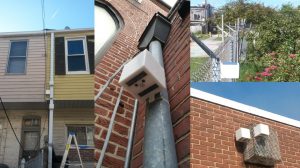 When one considers there was a Dallas city staffer at just about every meeting that led up to the creation of the Network, that these meetings began over a year ago, and that this specific presentation and vote has been scheduled for the Council’s review since August, it’s really quite incredible that staff admits they’ve spent no time thinking about how to implement this proposed policy within the city limits. Maybe because they’ve spent so much time trying to shoot it down.
When one considers there was a Dallas city staffer at just about every meeting that led up to the creation of the Network, that these meetings began over a year ago, and that this specific presentation and vote has been scheduled for the Council’s review since August, it’s really quite incredible that staff admits they’ve spent no time thinking about how to implement this proposed policy within the city limits. Maybe because they’ve spent so much time trying to shoot it down.
As late as the Friday before Monday’s vote staff was still at it, sending out a memo to Committee members downplaying the need for any regional network, conveying regulatory-correct but scientifically-misleading language about local Particulate Matter pollution levels, and writing one of the oddest sentences we’ve ever seen associated with air quality monitoring. In dismissing the formidable capabilities of the kind of low-cost high tech sensors the Clean Air Network will be using, Dallas Assistant City Manager Joey Zapata concluded, “These low-cost air sensors present new opportunities for uses beyond regulatory monitoring but are not yet able to provide direct measurements of real-time health impacts.“
That’s because that’s not what air pollution sensors or monitors do. None of them. Nada. Zero. Not even the really big and expensive ones the City currently operates for the State and EPA. They can only measure what levels of PM pollution are in the air you’re breathing, not what cancers, birth defects, strokes, heart attacks, diabetes problems, IQ loss, dementia or other illnesses that PM Pollution are causing “in real time” in your body as you breathe it in. No such Star-Trek-like technology exists.
In the real world researchers take the PM measurements recorded by sensors and correlate them to rates of illness. It’s a branch of science called epidemiology. The staff memo manages to completely confuse two wildly different scientific methods in a stunning, head-shaking way. It’d be flat-earth funny if it wasn’t, you know, the official position of Dallas City staff on the subject. Then it just becomes embarrassing.
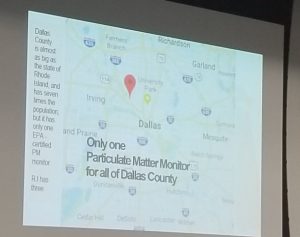 But whatever doubts about the Network staff tried to infect the council members with, they seemed to vanish once UTD Physics Professor Dr. David Lary and Downwinders’ Jim Schermbeck, representing the DFW Air Research Consortium, gave their 35-minute presentation on the Network.
But whatever doubts about the Network staff tried to infect the council members with, they seemed to vanish once UTD Physics Professor Dr. David Lary and Downwinders’ Jim Schermbeck, representing the DFW Air Research Consortium, gave their 35-minute presentation on the Network.
A roomful of “Clean Air Now” button-wearing supporters also helped the cause considerably. Thanks to everyone who came on an early Monday morning to make sure the Committee did the right thing. Thanks also to everyone who sent in emails to the Committee via our prepared Citizen Action website feature.
That combination of grassroots support plus technical expertise is one of the things that’s so impressive about this bottom-up approach, and it paid off again in the Committee meeting. Schermbeck made the case for change, Lary gave the details of how to build that change, monitor by monitor.
D Magazine published an online piece Monday morning that provides a point-by-point rationale for why this Network is A Big Idea Whose Time Has Come. Basically Big, Expensive and Slow has been replaced with Small, Cheap and Fast and it’s democratizing air quality information. All of that was included in the Committee presentation, plus examples of how it could have made a difference in the real world during a past crisis like the Sunshine Recycling Fire of December last year in West Dallas.
Both Plano and Dallas County officials have already said they’re onboard with the Network and may act to ratify the founding documents in their jurisdiction before the scheduled December Dallas vote. By the end of the year a new 21st Century regional air monitoring system, driven by local expertise, controlled by local governments, and designed to promote public health could become a reality.
But citizens may still have to fight to see it happen. In an ironic twist, the same staff that has been opposing the idea of Dallas joining the Network is now in charge of writing the briefing paper for the Council to explain why it’s a good idea. Bets are already being taken on how well they succeed.
ARC’s Network presentation was only half of an interesting compare and contrast exercise looking at two local projects using air sensors in two very different ways that Chair Sandy Greyson had arranged for the Committee.
The other half was a presentation by the Texas Nature Conservancy outlining their city staff-supported “resiliency” (i.e. Rockefeller) project, the “Breathe Easy” study proposing to place a PM and ozone monitor for two years at nine DISD schools that already see high student asthma and absenteeism rates, all below Interstate 30. Breathe Easy has already started spending money and needed no vote…although it was the first time any Council Committee had been briefed on it.
The study was supposed to get started back in August with the beginning of the school year but the nine schools haven’t been announced yet and so no monitors have been installed. Since the 2018-19 academic year is designed to provide a “baseline” of student asthma health, the study has already missed its chance of getting any data during the worst summer for ozone pollution in five years. It could take another month or longer to name the schools and wire-up the monitors. It’s uncertain how much this gap of missing information diminishes the value or definition of a baseline to which three specific intervention efforts are to be measured against beginning in the 2019-20 academic year.
Those intervention efforts include vehicle idling policies at or near schools, screens of vegetation between the 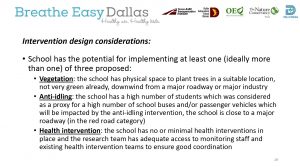 street and school, and in-school asthma therapies. The question being posed by the study is whether these intervention efforts have any impact on school-site pollution levels and therefore student asthma or absenteeism rates that can be measured.
street and school, and in-school asthma therapies. The question being posed by the study is whether these intervention efforts have any impact on school-site pollution levels and therefore student asthma or absenteeism rates that can be measured.
There’s certainly no harm in doing this study, but… its about ten years behind the times and spends a lot of money to tell us what we already know.
For example, we know DFW children’s asthma levels are higher than the national average. In their presentation, the TNC uses the 2009 Cook’s Children’s Hospital study made infamous by Downwinders almost a decade ago. That study contains the map showing a huge diagonal swath of childhood asthma running the length of Tarrant County that almost exactly syncs-up with the prevailing pollution plumes from the three Midlothian cement plants. Downwinders used that map time and again to prove the impact of the cement plants on downwind health during our Green Cement Campaign.
We know asthma is worse in minority communities. Many green groups were speaking out about this fact during the first wave of Environmental Justice activism during the 1990’s and have never stopped. What’s interesting is that TNC and the staff never ever talk about WHY this is a fact. It’s like they consider it an inherent genetic defect.
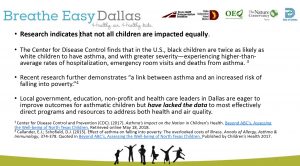 One reason might be that the Dallas City Hall staff now feigning concern for sick black kids is the same crew responsible for actively pressing racist zoning and land use planning in black and brown neighborhoods, like their predecessors before them.
One reason might be that the Dallas City Hall staff now feigning concern for sick black kids is the same crew responsible for actively pressing racist zoning and land use planning in black and brown neighborhoods, like their predecessors before them.
It was only last March when they were recommending approval for those two new batch plants in Joppa. Only last February when they recommended the Ash Grove Cement Silo in West Dallas. Before that they approved the move of the Argos batch plant from trendy Trinity Groves to a location next to a school in West Dallas.
Why do black kids have higher asthma rates in Dallas? Perhaps because the City of Dallas has designed it that way for over a century.
There is not a single note of contrition about this contradiction in the TNC or staff’s presentation on its Breathe Easy project. No “we’re sorry for putting people and polluters way too close in minority neighborhoods.” No “we’re going to do better from here on out – not just with these studies, but with actual policy.” No change in behavior, or even why there might need to be one, is ever discussed.
Those supporting the Breathe Easy study – or any other collaboration with the the Office of Environmental Quality and Rockefeller Sustainability – should understand they’re aligning themselves with a bureaucracy that’s been at the forefront of making the pollution problems in Joppa and West Dallas worse. And now the same bureaucracy wants to “study” the problem they helped make by testing out three piecemeal approaches to reducing exposure, rather than looking at how institutional changes could bring more fundamental and lasting solutions.
In the end, a year of intervention strategies at your school does little lasting good if you walk home through a polluted  neighborhood whose industries have been given a blank check by city staff.
neighborhood whose industries have been given a blank check by city staff.
We know reducing exposure to PM pollution improves your health. Lots and lots of studies show that.
We know which specific strategies work to reduce PM pollution. Buffer zones, vegetation screens, inside air filters, pollution controls, electrification of vehicles – all of these have been examined by researchers and found to reduce PM pollution levels. Even the Nature Conservancy cites the empirical success of tree planting in reducing pollution based on a past study. We don’t need a new study to tell us these strategies are effective. We need more money to implement them.
What the Breath Easy study seems to want to acquire is a new number – A, B and C intervention strategies reduce student asthma attacks/absenteeism by X, Y and Z amounts.
But can that be a meaningful, scientifically-robust number now that you only have an abbreviated baseline that excludes summer? Can it be meaningful if you only spend a year testing intervention strategies, including growing vegetation screens? Even applying copious amounts of Miracle Gro, your trees are not going to get that tall in 12 months.
Using all of TNC’s own data, a convincing case can be made that the $300,000 + being spent on this study could have been better spent on buying trees for those nine schools and installing them as PM screens. But that would have just reduced PM pollution. It wouldn’t have produced a study for the Rockefeller Foundation.
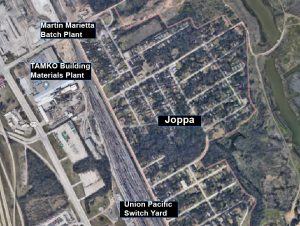 A dense regional Network of air monitors will begin to expose the deep disparities in pollution burdens in Dallas and elsewhere. It’ll provide a map to black and brown neighborhoods they don’t have now, providing further evidence that what you breathe in Dallas depends on where you live in Dallas. There’s plenty of indications this is the real disparity that Dallas City Hall staff are concerned with – even more than higher rates of black childhood asthma.
A dense regional Network of air monitors will begin to expose the deep disparities in pollution burdens in Dallas and elsewhere. It’ll provide a map to black and brown neighborhoods they don’t have now, providing further evidence that what you breathe in Dallas depends on where you live in Dallas. There’s plenty of indications this is the real disparity that Dallas City Hall staff are concerned with – even more than higher rates of black childhood asthma.
The curtains are about to part and provide a much clearer picture of how Dallas’ institutional racism has poisoned its own residents. It behooves everyone who calls themselves an environmentalist in Dallas in 2018 to commit to changing that picture, not just studying it.
New Study Finds PM in Placentas

Scientists already knew that maternal exposure to PM pollution had the potential to harm fetal development. Studies have documented higher rates of Autism, ADHD and other developmental diseases in close proximity of freeways and other large sources of PM pollution. But until now researches hadn’t actually identified how PM harmed newborns.
According to a study presented last week at the European Respiratory Society’s (ERS) international congress in Paris, researchers have found the first evidence that particles of air pollution travel through pregnant women’s lungs and lodge directly in their placentas.
Using an optical microscope, they examined the placentas of five non-smoking women who all delivered healthy babies. They found 72 dark particles among 3,500 cells and then used a powerful electron microscope to examine the shape of some of the particles. They looked like the sooty particles found in macrophages in the lung.
One of the study’s authors, Dr Lisa Miyashita of Queen Mary University of London, ruled out almost any other substance, “We can’t think of anything else they could be. It is very evident to us they are black sooty particles.” Dr Norrice Liu, also at Queen Mary University of London and part of the team stated, “We also know that the particles do not need to get into the baby’s body to have an adverse effect, because if they have an effect on the placenta, this will have a direct impact on the foetus.”
Almost every effort examining the health effects from PM pollution over the last decade have all concluded there’s no level of exposure that’s not capable of leaving some harm behind. What this new study indicates is that many of us may already be harmed by exposure even before we’re born and that may make additional exposure that much more harmful.
Just this past month two new reports were published that linked PM pollution to significant IQ loss and diabetes.
In separate research, also presented at the Paris congress, researchers found that children with early onset and persistent asthma fared far less well in education than those without the condition.
The study, conducted over 20 years in Sweden, showed that children with asthma were three and half times more likely to leave school at the age of 16 with only basic education and were also twice as likely to drop out of university courses

